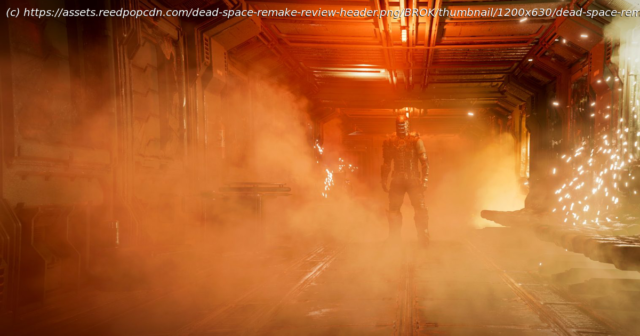While a fine piece of craft and a sumptuous reworking of the setting, EA Motive’s Dead Space remake sheds a little of the 2008 game’s enchantment.
The not-so-good ship ISG Ishimura is around 62 years old by the time Isaac Clarke arrives there in Dead Space. During its long career as a „planet cracker“, this unpleasant hybrid of Nostromo and whaling vessel has been modded and expanded in grander and smaller ways. Even playing a newcomer – part of a small team sent to repair the Ishimura following a loss of comms – you feel that history of alterations as you stomp from sector to sector, fixing up broken systems while demolishing the, as it transpires, horribly mutated undead remnants of the crew.
Each section is an architectural battle between elementary worker needs such as guardrails and the requirements of enormous machines, with the argument typically falling in the machines‘ favour. The age and quality of the fittings also reflects a corporate class divide: the bridge is a gleaming concert stage with fancy free-standing glass displays, while the mining and maintenance decks are a warren of rust and asteroid debris, with huge turbines roaring away inches overhead. It often feels like more thought has been given to the placing of snack vending machines than life-saving fixtures like O2 dispensers. The aforesaid zombies or „Necromorphs“ have set their own stamp on the décor, filling whole decks with carpets of grumpy biomatter, and turning every human-sized vent into an object of menace.
It’s not a great place to call home, even if you’re an officer, but it’s an engrossing play environment – give or take its clownish lore graffiti, anyway. Revisiting the 2008 game last year in anticipation of this year’s meticulous but in key respects, disappointing remaster, I was struck by how Dead Space layers up your understanding of the Ishimura by shuttling you back and forth, entering layouts from different angles with different objectives. Admittedly, the fact that literally every mechanism you need to survive has to be fixed grows absurd towards the finish. But the payoff is that the environment feels persistent and alive in a way, say, the prison of spiritual sequel The Callisto Protocol never did for me. Dead Space is celebrated for its devoted yet distinctive spin on Giger – from the outside, the orbiting Ishimura looks like an enormous facehugger drifting above a ruptured egg – but it’s the way the game keeps you moving around and reappraising the setting that makes it such an evocative haunted house.
Part of the remaster’s intrigue is comparing the Ishimura’s in-world history of modification to the developer’s own renovations, which broadly aim to recuperate what was once an experimental (by EA’s standards) one-off into the larger storyline and franchise Dead Space would spawn. There’s the base visual overhaul, which adds details, depths and, indeed, guts to the game’s already busy contours. Much as the Necromorphs now consist of layers of tissue that slough away under fire, so hitherto flat walls now teem with sunken, baroque flourishes. The poisoned air has additional texture, shaping the light in nasty, unquantifiable ways, while sound travels differently depending on the intervening objects and materials. But the changes aren’t just about ambience.
There are new rooms tucked in amongst the old layouts – add-on chambers for a handful of side missions that deepen the fates of certain characters, including Dr Mercer and his awful Hunter. Some areas and their tasks have been totally transformed: the original game’s mounted-gun asteroid blasting sequence now sees you zipping around in zero-G (the remaster borrows Dead Space 2’s more user-friendly jetpack), synching the ship’s cannons to your weapons while boulders rain down on the hull. The annoying boss battles are back, yellow-painted weakpoints and all, but there’s a sprinkling of worthwhile new puzzle variables, such as circuit-breaker panels which invite you to choose between, say, switching off the oxygen or the lights in order to power another system.
Some rooms or storage containers now require you to have a certain security level, which increases at story-triggered intervals – an incentive to revisit cleared areas using the redesigned tram system, which is no longer a chapter-ending device but more of a level-select hub, with main and side objectives flagged on the tube map.
Start
United States
USA — software Dead Space remake review – a horror original re-engineered as a franchise...






